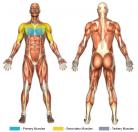Flat Bench Crossover Flys (Cable)
- Set a bench to a flat position, and attach a single grip cable attachment to both sides of a low-set pulley.
- Sit, lean over, and grasp an attachment on one side and then the other. Depending on the amount of weight chosen, it may be difficult to get into the proper starting position. Normally, if the weight is particularly heavy, rowing the grip inward toward the torso and then quickly rotating the grips to your upper abdomen will prove to be an effective method to get into the proper starting position.
- Slowly lie backward onto the bench, and then press the weight upward until your arms are nearly fully extended. This is the starting position. The cable attachments should be grasped with a neutral grip (i.e. with your palms facing one another).
- Slowly lower the cable attachments outward to your sides--keeping your arms slightly bent--until your arms are parallel with the ground (horizontal), inhaling throughout the movement. Note: You need not lower your arms this low, so do not do so unless your are comfortable doing so.
- Raise the cable attachments until they nearly meet at the top (above your chest), exhaling throughout the movement.
- Repeat steps 4-5 for as many repetitions as are desired.
When the arms are together above the chest that the inner chest (sternal head) is most optimally contracted. If your aim is to work the inner aspect of the chest, then pay extra attention to the squeeze at the very end of the positive motion (where the arms meet above your chest). Isometrically contract your chest muscles to achieve full sternal head muscular recruitment, i.e. hold the squeeze briefly before you begin to lower for the next repetition. There is no need to clank the dumbbells together to achieve full isometric contraction.
The fully-stretched, "lowered" aspect of the motion is where the outer chest is most optimally contracted. If your aim is to work the outer aspect of the chest, then pay extra attention to the stretch at the very end of the negative motion (where the arms are back/down). Do note, however, that both the pectorals and anterior deltoids are particularly vulnerable to injuries when in this position.
Flat bench crossover flys work the pectoralis major muscles (i.e. the main, large chest muscles), to include both the sternal head (i.e. inner aspect of the chest--which they are particularly good at targeting), clavicular head (i.e. the upper aspect of the chest), and outer aspect of the chest. In addition to working the pectorals, this exercise works the coracobrachialis and the short head of the biceps.
The negative aspect (when the arms are outstretched to the sides and back) is conventionally considered a hazardous aspect of any sort of fly exercise. Although cable flys do not pose quite the hazard that dumbbell flys do, care must still be taken to avoid injury. When the arms are outstretched to the sides and back, tremendous stress is put on the anterior shoulders and pectorals, especially with heavy weight usage. Biceps injuries, though far less common, do also occur with flys. As a general rule, if not familiar with flys or if pain is felt, use good judgment and only use weight amounts that you are comfortable with. Also, do not feel obligated to fully stretch your pectorals with this exercise.





